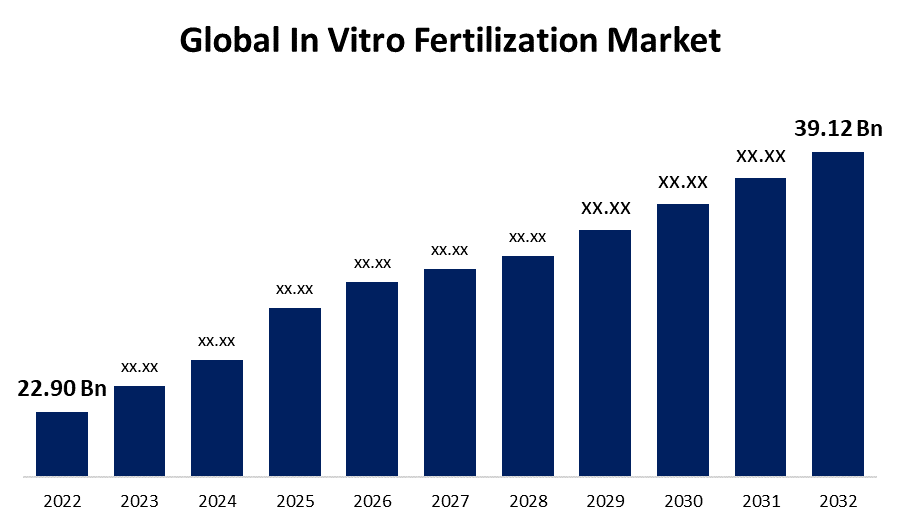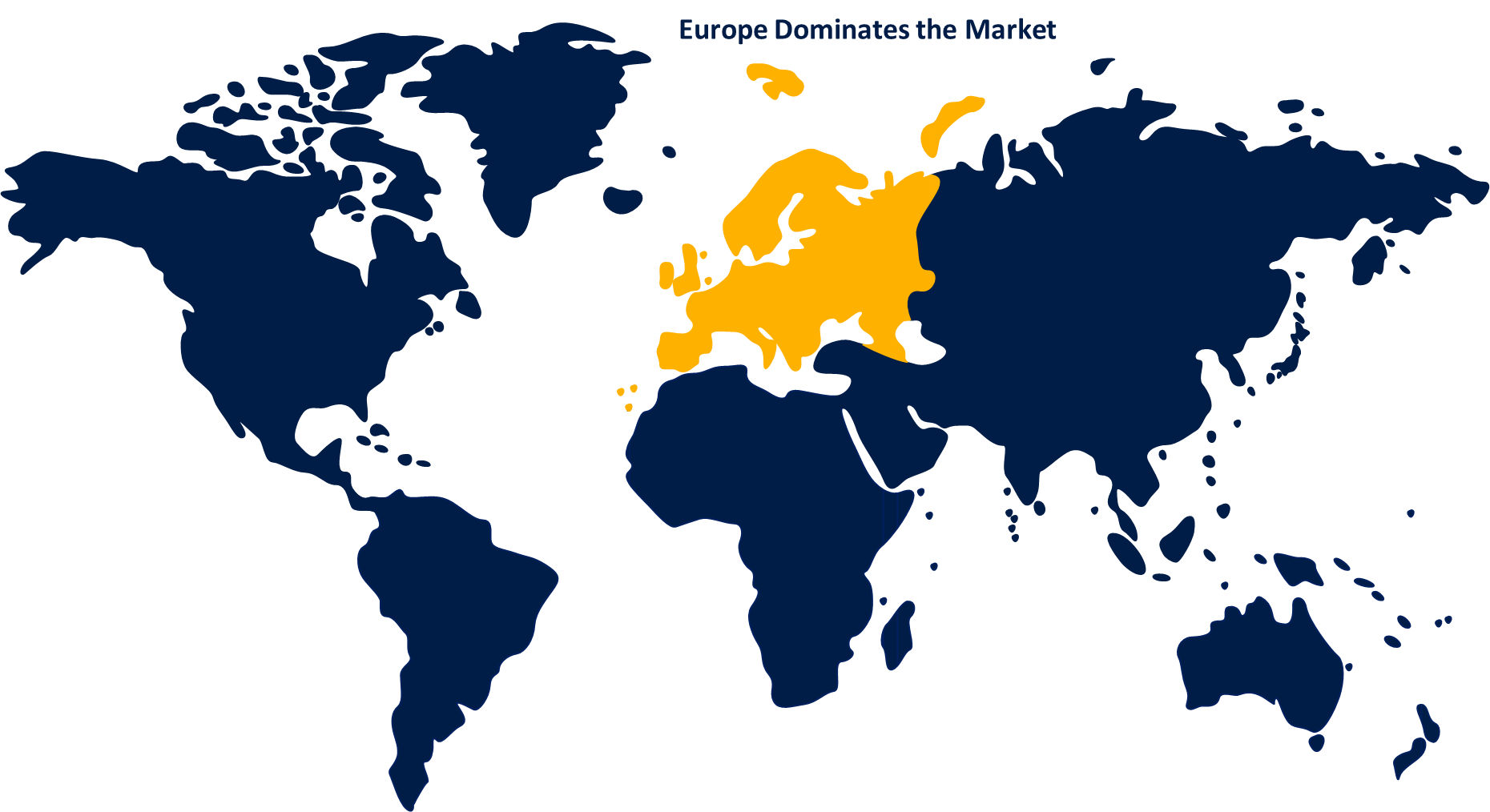Global In Vitro Fertilization Market Size, Share, and COVID-19 Impact Analysis, By Instrument (Disposable Devices, Culture Media, and Capital Equipment), By Procedure Type (Fresh Donor, Frozen Donor, Fresh Non-donor, and Frozen Non-donor), By End-Use (Fertility Clinics and Hospitals & Others Setting), By Region (North America, Europe, Asia-Pacific, Latin America, Middle East, and Africa), Analysis and Forecast 2022 - 2032
Industry: HealthcareGlobal In Vitro Fertilization Market Insights Forecasts to 2032
- The Global In Vitro Fertilization Market Size was valued at USD 22.90 Billion in 2022.
- The Market Size is Growing at a CAGR of 5.5% from 2022 to 2032
- The Global In Vitro Fertilization Market Size is expected to reach USD 39.12 Billion by 2032
- Asia-Pacific is expected to Grow fastest during the forecast period

Get more details on this report -
The Global In Vitro Fertilization Market Size is expected to reach USD 39.12 Billion by 2032, at a CAGR of 5.5% during the forecast period 2022 to 2032.
Market Overview
In Vitro Fertilization (IVF) is a groundbreaking assisted reproductive technology that enables individuals and couples struggling with infertility to conceive. This procedure involves the controlled stimulation of a woman's ovaries to produce multiple eggs, which are then harvested and combined with sperm in a laboratory setting. The resulting embryos are closely monitored for quality and development, and one or more healthy embryos are selected for transfer into the woman's uterus. IVF can be tailored to address various infertility causes, such as fallopian tube blockages, low sperm count, or unexplained fertility issues. It offers hope to those facing reproductive challenges, including same-sex couples and single individuals, and has led to the birth of countless healthy babies worldwide. Despite its success, IVF can be physically and emotionally demanding, often requiring multiple cycles to achieve a successful pregnancy.
Report Coverage
This research report categorizes the market for in vitro fertilization market based on various segments and regions and forecasts revenue growth and analyzes trends in each submarket. The report analyses the key growth drivers, opportunities, and challenges influencing the in vitro fertilization market. Recent market developments and competitive strategies such as expansion, product launch, and development, partnership, merger, and acquisition have been included to draw the competitive landscape in the market. The report strategically identifies and profiles the key market players and analyses their core competencies in each sub-segments of the in vitro fertilization market.
Global In Vitro Fertilization Market Report Coverage
| Report Coverage | Details |
|---|---|
| Base Year: | 2022 |
| Market Size in 2022: | USD 22.90 Billion |
| Forecast Period: | 2022-2032 |
| Forecast Period CAGR 2022-2032 : | 5.5% |
| 2032 Value Projection: | USD 39.12 Billion |
| Historical Data for: | 2018-2021 |
| No. of Pages: | 200 |
| Tables, Charts & Figures: | 110 |
| Segments covered: | By Instrument, By Procedure Type, By End-Use, By Region and COVID-19 Impact Analysis. |
| Companies covered:: | Bayer AG, Boston IVF, Cook Medical LLC, EMD Serono, Inc., Ferring B.V., FUJIFILM Holdings Corporation, Genea Biomedx, Merck & Co., Inc., OvaScience, Inc., Progyny, Inc., The Cooper Companies, Inc., Thermo Fisher Scientific, Inc., Vitrolife, and other key vendors. |
| Pitfalls & Challenges: | COVID-19 Empact, Challenge, Future, Growth, & Analysis |
Get more details on this report -
Driving Factors
The in vitro fertilization (IVF) market is driven by a combination of factors that collectively contribute to its growth and expansion, such as the increasing prevalence of infertility issues, partly attributed to lifestyle factors like delayed childbearing and rising stress levels, is a significant driver. As couples and individuals face difficulties conceiving naturally, the demand for IVF procedures surges. The advancements in medical technology and reproductive science have continually improved the success rates of IVF treatments, making it a more attractive option for those seeking fertility solutions. Innovations in techniques like intracytoplasmic sperm injection (ICSI), preimplantation genetic testing (PGT), and cryopreservation have enhanced the efficacy of IVF procedures. Moreover, the expanding acceptance of alternative family structures, including same-sex couples and single individuals, has widened the potential market for IVF. IVF offers them the opportunity to start or expand their families, further bolstering demand. Another driver is the growing awareness and accessibility of fertility treatments. Increasingly, people are becoming more informed about their reproductive options and are seeking medical assistance earlier, which leads to a higher adoption rate of IVF treatments. Furthermore, favorable government policies and insurance coverage in some regions can significantly reduce the financial burden associated with IVF, making it more accessible to a broader demographic. Additionally, the trend toward delayed parenthood, driven by career pursuits and economic factors, has led to a rise in the average age of first-time parents. This trend often necessitates fertility treatments like IVF, further propelling market growth. A surge in medical tourism for IVF treatments, with patients traveling to countries with advanced and cost-effective services, has expanded the global reach of the IVF market.
Restraining Factors
The in vitro fertilization (IVF) market faces several constraints, including its high cost, which can be prohibitive for many individuals or couples. The physical and emotional toll of multiple IVF cycles, often required for success, can also deter some from pursuing treatment. Ethical and religious concerns may lead to resistance or limited acceptance of IVF in certain regions or communities. Additionally, there is no guarantee of success, leading to potential disappointment and financial strain. Regulatory challenges and variations in insurance coverage further limit accessibility. There is a need for skilled medical professionals and specialized facilities, which may be lacking in some areas, hindering widespread adoption.
Market Segmentation
- In 2022, the culture media segment accounted for around 42.5% market share
On the basis of the instrument, the global in vitro fertilization market is segmented into disposable devices, culture media, and capital equipment. The dominance of the culture media segment in the in vitro fertilization (IVF) market is attributed to its essential role in the success of IVF procedures. Culture media are crucial for nurturing and supporting the growth of embryos in the laboratory setting. Advances in culture media formulations have significantly improved embryo development rates and the overall success of IVF treatments. Fertility clinics and laboratories rely heavily on high-quality culture media, making it a fundamental component of IVF procedures and resulting in its largest revenue share in the market.
- The frozen non-donor segment held the largest market with more than 46.2% revenue share in 2022
Based on the procedure type, the global in vitro fertilization market is segmented into fresh donor, frozen donor, fresh non-donor, and frozen non-donor. The dominance of the frozen non-donor segment in the in vitro fertilization (IVF) market is primarily due to its broader applicability and higher success rates. Frozen non-donor embryos offer advantages like flexibility in timing and lower cost compared to fresh cycles. Patients can undergo multiple IVF attempts using frozen embryos, increasing the chances of success. Additionally, advancements in cryopreservation techniques have improved the viability of frozen embryos. These factors have made frozen non-donor IVF a preferred choice for many individuals and couples, resulting in its largest revenue share in the market.
- The fertility clinics segment held the largest market with more than 74.6% revenue share in 2022
Based on the end-use, the global in vitro fertilization market is segmented into fertility clinics and hospitals & others setting. The dominance of the fertility clinics segment in the in vitro fertilization (IVF) market can be attributed to its pivotal role as the primary service provider for IVF treatments. Fertility clinics specialize in offering a comprehensive range of assisted reproductive services, including IVF, making them a one-stop solution for individuals and couples seeking fertility treatments. Their expertise, state-of-the-art facilities, and experienced medical professionals attract a significant patient base. Moreover, fertility clinics often provide personalized care, further enhancing their appeal and contributing to their largest revenue share in the IVF market.
Regional Segment Analysis of the In Vitro Fertilization Market
- North America (U.S., Canada, Mexico)
- Europe (Germany, France, U.K., Italy, Spain, Rest of Europe)
- Asia-Pacific (China, Japan, India, Rest of APAC)
- South America (Brazil and the Rest of South America)
- The Middle East and Africa (UAE, South Africa, Rest of MEA)
Europe dominated the market with more than 35.2% revenue share in 2022.

Get more details on this report -
Based on region, Europe's dominant position in the In Vitro Fertilization (IVF) market can be attributed to the region boasts advanced healthcare infrastructure and a high level of technological expertise, facilitating the widespread availability of IVF clinics and services. Favorable government policies and comprehensive insurance coverage in many European countries alleviate the financial burden on patients, making IVF more accessible. Additionally, Europe's aging population and increasing awareness of fertility issues have led to a growing demand for IVF treatments.
Asia-Pacific's anticipated rapid growth in the in vitro fertilization (IVF) market is driven by several factors. The region's booming population, coupled with changing lifestyles, has led to a rising incidence of infertility issues. Moreover, increasing awareness about IVF options, expanding healthcare infrastructure, and improving economic conditions are making IVF treatments more accessible to a broader demographic. As societal norms evolve and the acceptance of assisted reproductive technologies grows, Asia-Pacific is positioned to witness significant demand for IVF services, making it the fastest-growing region in the global IVF market over the forecast period.
Recent Developments
- In June 2023, Progyny, Inc. and Quantum Health, Inc. have joined forces to bring Quantum Health's Comprehensive Care treatments platform for family formation and reproductive treatments to market.
- In January 2022, Boston IVF, one of the world's most experienced fertility clinics, has joined forces with the Delaware Institute for Reproductive Medicine (DIRM). The unique collaboration intends to provide world-class fertility treatments and care locally through novel therapies such as IVF, preimplantation genetic testing, male infertility, and others.
Competitive Analysis:
The report offers the appropriate analysis of the key organizations/companies involved within the global in vitro fertilization market along with a comparative evaluation primarily based on their product offering, business overviews, geographic presence, enterprise strategies, segment market share, and SWOT analysis. The report also provides an elaborative analysis focusing on the current news and developments of the companies, which includes product development, innovations, joint ventures, partnerships, mergers & acquisitions, strategic alliances, and others. This allows for the evaluation of the overall competition within the market.
List of Companies:
- Bayer AG
- Boston IVF
- Cook Medical LLC
- EMD Serono, Inc.
- Ferring B.V.
- FUJIFILM Holdings Corporation
- Genea Biomedx
- Merck & Co., Inc.
- OvaScience, Inc.
- Progyny, Inc.
- The Cooper Companies, Inc.
- Thermo Fisher Scientific, Inc.
- Vitrolife
Key Target Audience
- Market Players
- Investors
- End-Users
- Government Authorities
- Consulting and Research Firm
- Venture Capitalists
- Value-Added Resellers (VARs)
Market Segment
This study forecasts revenue at global, regional, and country levels from 2019 to 2032. Spherical Insights has segmented the global in vitro fertilization market based on the below-mentioned segments:
In Vitro Fertilization Market, By Instrument
- Disposable Devices
- Culture Media
- Capital Equipment
In Vitro Fertilization Market, By Procedure Type
- Fresh Donor
- Frozen Donor
- Fresh Non-donor
- Frozen Non-donor
In Vitro Fertilization Market, By End-Use
- Fertility Clinics
- Hospitals & Others Setting
In Vitro Fertilization Market, Regional Analysis
- North America
- US
- Canada
- Mexico
- Europe
- Germany
- UK
- France
- Italy
- Spain
- Russia
- Rest of Europe
- Asia Pacific
- China
- Japan
- India
- South Korea
- Australia
- Rest of Asia Pacific
- South America
- Brazil
- Argentina
- Rest of South America
- Middle East & Africa
- UAE
- Saudi Arabia
- Qatar
- South Africa
- Rest of Middle East & Africa
Need help to buy this report?